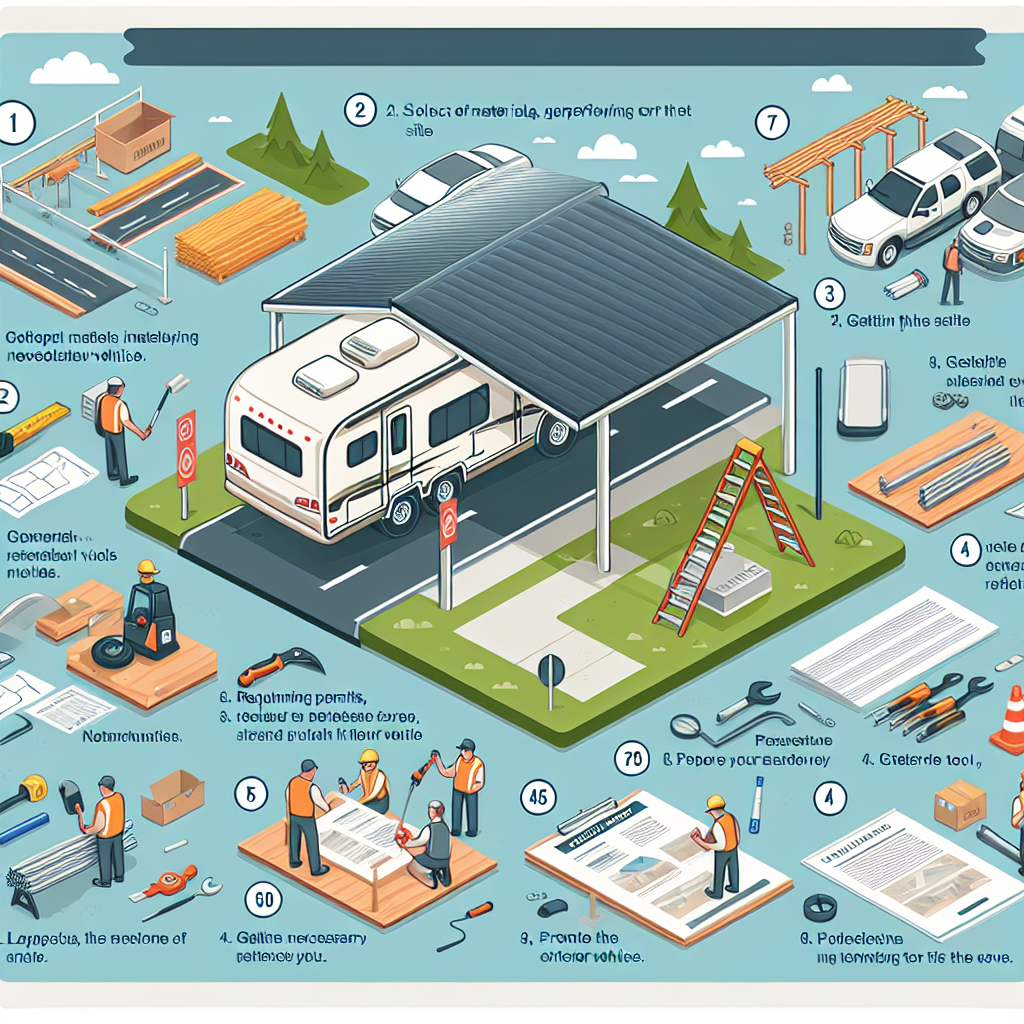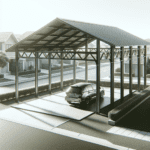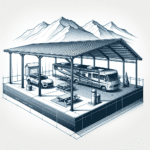Are you considering installing a carport for your RV? Look no further! In this comprehensive guide, we will provide you with all the information you need to know about RV carport installation. From understanding the benefits of having a carport to step-by-step instructions on how to install one, we’ve got you covered. Whether you’re a seasoned RV owner or a newbie, this article will equip you with the knowledge to make an informed decision and ensure your beloved vehicle is well-protected. So, let’s get started on transforming your RV parking situation for the better!
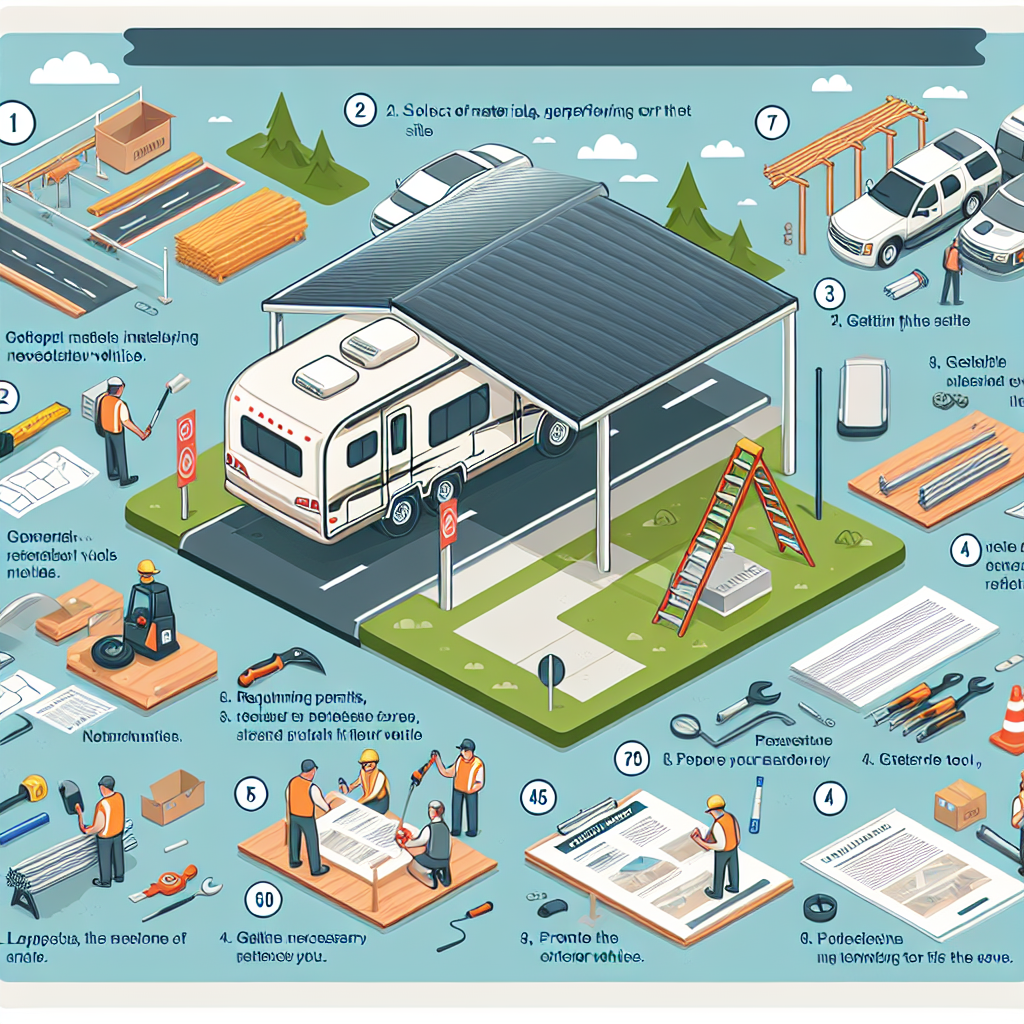
Planning the RV Carport Installation
Choosing the Right Location
When planning the installation of an RV carport, one of the first things you need to consider is choosing the right location. The location should be convenient and easily accessible, allowing you to maneuver your RV in and out without any hassle. Consider factors such as the proximity to your driveway or garage, as well as any obstructions or potential hazards that may pose a problem during installation. Ideally, the location should be on level ground to ensure stability and proper drainage.
Researching Local Regulations and Permits
Before embarking on an RV carport installation, it is crucial to research and familiarize yourself with the local regulations and permits required in your area. Depending on where you live, there may be specific building codes and guidelines that dictate the size, placement, and design of carports. Contact your local building department or zoning office to inquire about the necessary permits and any restrictions you need to adhere to. It’s important to ensure that your planned carport installation is in compliance with these regulations to avoid any legal issues in the future.
Determining the Size and Design
When determining the size and design of your RV carport, you need to consider the dimensions of your RV and any additional vehicles or equipment you plan to shelter under the carport. Measure the length, width, and height of your RV, and add extra space to accommodate for any slide-outs or accessories. Additionally, consider whether you want an open or enclosed carport, as well as any features such as a built-in storage area or a covered patio space. Take into account the aesthetic appeal of the design to ensure it complements the overall look of your property.
Considering Site Preparation
Site preparation is a crucial step in the RV carport installation process. Before starting construction, you need to clear the site of any debris, vegetation, or objects that may hinder the installation. Ensure that the ground is level and compacted to provide a stable foundation for the carport. It’s also important to consider the site’s drainage to prevent water buildup and potential damage to your RV. If necessary, consult a professional to ensure proper site preparation before proceeding with the installation.
Preparing for the RV Carport Installation
Gathering Materials and Tools
To successfully install an RV carport, you’ll need to gather the necessary materials and tools. This may include lumber, metal posts, concrete, screws, roofing materials, and various hand and power tools. Take inventory of all the required materials, making sure you have everything on hand to avoid delays during the installation process. Having the proper tools readily available, such as drills, saws, and levels, will ensure a smoother and more efficient installation.
Checking for Utilities and Underground Lines
Before digging or placing any supports for your RV carport, it’s essential to check for any underground utilities such as water pipes, gas lines, or electrical cables. Contact your local utility companies to schedule a utility locate service. This will prevent accidental damage to these lines during the installation process, ensuring your safety and preventing expensive repairs. It’s better to be safe and informed than to encounter unforeseen issues later on.
Clearing and Leveling the Site
Preparing the site for an RV carport installation requires clearing away any obstructions on the ground. Remove rocks, large tree roots, or any other debris that may affect the stability of the structure. Once cleared, it’s crucial to level the site to ensure an even foundation for the carport. Use a level and a measuring tape to verify that the ground is flat and adjust as necessary. A properly leveled site will prevent any potential issues, such as water pooling or an unstable carport structure.
Creating a Foundation
A solid foundation is vital for the stability and longevity of your RV carport. Depending on the design and requirements of your chosen carport, you may need to create a concrete foundation. This typically involves digging post holes, pouring concrete footings, and setting anchor bolts. Follow the manufacturer’s instructions and local building codes to ensure proper installation. A well-built foundation will provide a secure base for your RV carport, allowing it to withstand various weather conditions and prolonging its lifespan.
Selecting the RV Carport
Understanding Different Carport Types
When selecting an RV carport, it’s important to understand the different types available. The most common types include standalone carports, attached carports, and portable carports. Standalone carports are freestanding structures that are not connected to any existing buildings. Attached carports, on the other hand, are connected to an existing structure, such as a house or garage. Portable carports offer flexibility in terms of relocation and are often made with lightweight materials. Consider your specific needs and preferences when choosing the type of carport that best suits your requirements.
Considering Materials and Durability
RV carports are typically made from various materials, including wood, metal, and fabric. Each material has its own advantages and drawbacks in terms of durability, aesthetics, and maintenance requirements. Metal carports, such as those made from steel or aluminum, are known for their strength and longevity. Wooden carports offer a more natural and traditional look, but require regular maintenance to prevent rotting or warping. Fabric carports are lightweight and easy to assemble, but may not provide the same level of durability as their metal or wooden counterparts. Evaluate the pros and cons of each material to choose the one that best suits your needs.
Choosing the Right Size and Height
Selecting the right size and height for your RV carport is crucial to ensure proper coverage and clearance for your vehicle. Measure the dimensions of your RV, including its length, width, and height, to determine the minimum size requirements for the carport. It’s advisable to choose a carport that provides ample space around the vehicle for easy access and maintenance. Additionally, consider the height of your RV, including any roof-mounted equipment or accessories, to ensure the carport offers sufficient clearance. It’s important to account for potential growth or changes in your RV’s size when selecting the carport dimensions.
Evaluating Additional Features and Accessories
When selecting an RV carport, it’s worth considering additional features and accessories that can enhance its functionality and convenience. Some carports come with built-in storage solutions, such as enclosed lockable areas or open shelving, providing space for storing tools, equipment, or outdoor gear. You may also find carports that offer integrated lighting fixtures or electrical outlets, allowing you to easily access power for lighting or charging purposes. Additionally, consider features such as gutter systems for proper rainwater management or the option to add side panels or curtains for added protection and privacy. Evaluate these additional features and accessories to customize your RV carport to best suit your needs.
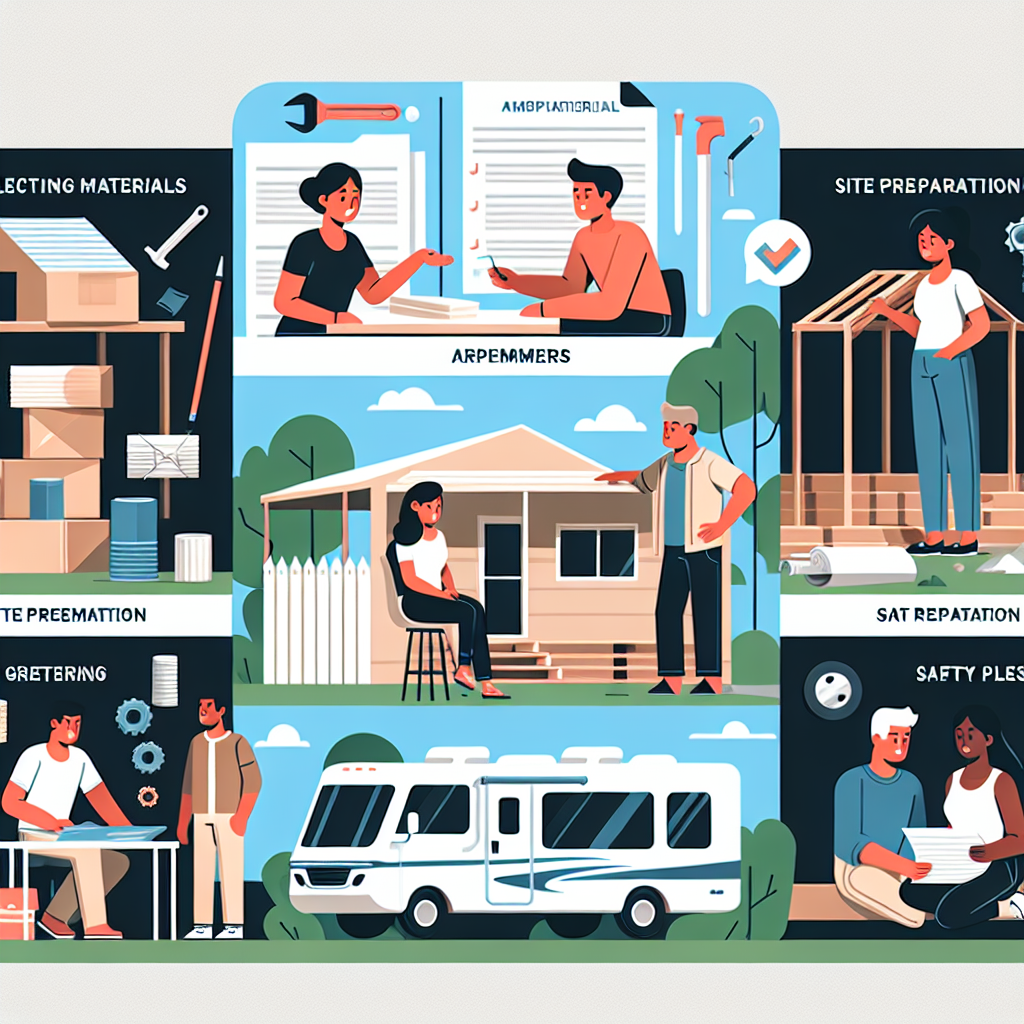
Building the RV Carport
Reading and Understanding the Instructions
Before starting the construction of your RV carport, it’s important to carefully read and understand the manufacturer’s instructions. Familiarize yourself with the step-by-step process, as well as any safety precautions or specific tools required. Make sure you have all the necessary components and verify that nothing is missing or damaged. Following the instructions accurately will ensure a successful and efficient installation, reducing the risk of errors or complications along the way.
Assembling the Structure
Once you have familiarized yourself with the instructions, it’s time to start assembling the structure of the RV carport. Begin by laying out the main components, such as the posts, beams, and trusses, in the designated areas. Follow the instructions to connect the pieces securely, using the appropriate fasteners or connectors provided. Ensure that each component is level and plumb to maintain the structural integrity of the carport. Depending on the complexity of the design, you may need additional help or specialized tools to properly assemble the carport.
Anchoring and Securing the Carport
To ensure stability and resistance to strong winds or other external forces, it’s crucial to properly anchor and secure your RV carport. This typically involves attaching the carport to the ground using anchor bolts or concrete anchors. Follow the manufacturer’s instructions to determine the appropriate anchoring method based on the type of carport you have chosen. It’s important to anchor the carport securely to prevent it from shifting or collapsing, providing a safe and dependable shelter for your RV.
Installing Roof Panels and Sides
Once the main structure of the carport is assembled and secured, it’s time to install the roof panels and sides. Depending on the type of carport, this may involve attaching metal roofing sheets, installing fabric coverings, or building and installing wooden panels. Follow the instructions to properly install and secure the roof panels, ensuring a water-tight and durable covering for your RV. If your carport has sides or walls, carefully attach them according to the manufacturer’s guidelines. Be meticulous in sealing any gaps or joints to prevent water leakage and protect your RV from the elements.
Adding Optional Features to the RV Carport
Installing Lighting and Electrical Outlets
Installing lighting and electrical outlets in your RV carport can enhance its functionality and convenience. Consider adding exterior lighting fixtures to provide ample illumination during dark hours, facilitating safe navigation around the RV. Depending on local regulations and electrical capabilities, you may also choose to install electrical outlets for easy access to power. This could be useful for charging batteries, running tools, or connecting other electrical devices while working on or near your RV.
Incorporating Storage Solutions
To maximize the utility of your RV carport, consider incorporating storage solutions to keep your outdoor equipment, tools, or RV accessories organized and protected. This could involve adding shelves, cabinets, or lockable containers within the carport structure. Utilize these storage solutions to store items such as leveling blocks, hoses, maintenance tools, or camping gear. By keeping everything in its designated place, you can maintain a clean and clutter-free environment, making it easier to access and use your RV.
Adding Solar Panels for Power
Incorporating solar panels into your RV carport design can provide a sustainable source of power for your RV. Solar panels capture sunlight and convert it into electricity, which can be stored in batteries and used to power various appliances and systems in your RV. Consider the optimal placement of the solar panels to maximize sun exposure throughout the day. Consult with a professional to determine the appropriate solar panel capacity based on your energy requirements. By utilizing solar power, you can reduce your reliance on external power sources and enjoy the benefits of clean, renewable energy.
Enhancing the Carport with Aesthetics
While the primary purpose of an RV carport is to protect your vehicle, it doesn’t mean you can’t enhance its aesthetic appeal. Consider incorporating decorative elements or landscaping around the carport to complement your property’s overall aesthetics. This could involve adding potted plants, flower beds, or decorative stones. Additionally, consider painting or staining the carport structure to match your home’s color scheme or personal preferences. These small touches can greatly contribute to the overall look and feel of your RV carport, creating a visually pleasing addition to your property.
RV Carport Maintenance and Protection
Regular Cleaning and Inspections
To keep your RV carport in optimal condition, regular cleaning and inspections are essential. Remove any leaves, branches, or debris that may accumulate on the carport’s roof or sides. Regularly inspect the carport’s structure for signs of damage, such as rust, loose fasteners, or bent beams. Promptly address any issues to prevent further deterioration or compromise to the carport’s integrity. Additionally, inspect the roof panels for any cracks or leaks, ensuring that your RV remains protected from water damage.
Maintaining Paint and Coatings
If your RV carport features a painted or coated surface, proper maintenance is necessary to ensure its longevity. Over time, exposure to the elements can cause paint to fade or coatings to deteriorate. Regularly inspect the carport’s surface for any signs of peeling, chipping, or discoloration. If needed, clean the surface thoroughly and apply a fresh coat of paint or protective coating. This will not only enhance the carport’s appearance but also provide an additional layer of protection against corrosion and weathering.
Protecting Against Harsh Weather
RV carports are designed to withstand various weather conditions, but taking additional precautions can further protect your RV from harsh elements. During extreme weather events, such as storms or heavy snowfall, consider covering your RV with a protective tarp or specialized cover. This will provide an extra layer of insulation and prevent any potential damage caused by high winds or heavy snow accumulation. Additionally, ensure that the carport’s roof and sides are maintained and water-tight to prevent leaks or water damage during rainy periods.
Ensuring Proper Drainage
Proper drainage is vital to prevent water accumulation and potential damage to both your RV and the carport structure. Regularly inspect the carport’s gutters, downspouts, and drain channels to ensure they are clear of debris and functioning properly. Remove any leaves or other obstructions to allow for smooth water flow. If necessary, consider extending downspouts or directing water away from the carport area to prevent pooling and protect against potential foundation damage. Proper drainage will help maintain the structural integrity of your RV carport and ensure the longevity of your RV.
Costs Associated with RV Carport Installation
Understanding Pricing Factors
The cost associated with RV carport installation varies depending on several factors. The size of the carport, the materials used, additional features or accessories, and the complexity of the design all contribute to the overall cost. Additionally, labor costs, including whether you choose to hire professionals or opt for a do-it-yourself approach, will affect the total expenses. Research and obtain quotes from different suppliers and contractors to have a better understanding of the pricing factors involved in your specific project.
Budgeting for Materials and Labor
When planning for an RV carport installation, it’s critical to budget for both materials and labor costs. Take into account the quantity and quality of materials needed, factoring in any additional features or accessories you desire. Obtain quotes or estimates from suppliers to determine the material costs accurately. If you choose to hire professionals for the installation, research and obtain quotes from multiple contractors to compare labor costs. Be sure to factor in any additional expenses such as permits, delivery fees, or equipment rentals to establish a realistic budget for your project.
Comparing DIY vs. Professional Installation
Deciding between a do-it-yourself (DIY) installation and hiring professionals is a crucial consideration when installing an RV carport. DIY installations can potentially save you money on labor costs but require a significant time commitment and a certain level of construction knowledge and skills. Hiring professionals, on the other hand, ensures a quicker and potentially smoother installation process, but comes with associated labor costs. Consider your own capabilities, available time, and the complexity of the installation when deciding whether to tackle the project yourself or hire professional help. Weigh the pros and cons to make an informed decision that suits your specific needs and budget.
Considering Long-term Financial Benefits
While the initial cost of an RV carport installation may seem significant, it’s important to consider the long-term financial benefits. Having a dedicated shelter for your RV can extend its lifespan by protecting it from the elements, reducing the risk of damage and deterioration. This can potentially save you money on costly repairs or premature replacement of your RV. Additionally, a well-constructed and aesthetically appealing RV carport can enhance the value of your property, potentially providing a return on your investment if you decide to sell in the future. By weighing the long-term financial benefits, you can make an informed decision regarding your RV carport installation.
Benefits of Installing an RV Carport
Protection from the Elements
One of the primary benefits of installing an RV carport is the protection it offers from the elements. Exposure to harsh weather conditions such as rain, snow, and UV rays can cause significant damage to your RV’s exterior, leading to costly repairs or premature aging. An RV carport shields your vehicle from rain, preventing water leaks and potential interior damage. It also shields your RV from snow accumulation, reducing the risk of roof collapses and ice-related damages. Additionally, the shade provided by a carport helps protect your RV’s paint and interior from the damaging effects of direct sunlight.
Extended Lifespan of the RV
By providing shelter and protection, an RV carport can significantly extend the lifespan of your vehicle. Constant exposure to the elements, such as rain, sun, and extreme temperatures, can cause premature deterioration of your RV’s exterior components, including the roof, siding, and paint. Over time, this can lead to costly repairs and reduced resale value. By keeping your RV sheltered in a carport, you can minimize exposure to these damaging factors, allowing your vehicle to maintain its structural integrity and appearance for a longer period.
Convenience and Accessibility
Installing an RV carport enhances the convenience and accessibility of your RV. Rather than storing your vehicle at a remote location, such as a storage facility or off-site parking lot, a carport provides easy and convenient access to your RV whenever you need it. This allows you to perform routine maintenance, inspections, or cleaning without the hassle of traveling to a separate location. The close proximity also facilitates quick and easy loading and unloading of your RV, reducing the time and effort required for your travels or recreational activities.
Increased Property Value
Beyond the immediate benefits to your RV, installing an RV carport can also increase the value of your property. A well-constructed and aesthetically pleasing carport structure adds curb appeal and visual appeal to your home, enhancing its overall value. Additionally, potential buyers may view the presence of an RV carport as a desirable feature, especially for RV owners or outdoor enthusiasts. By investing in an RV carport installation, you can potentially increase the marketability and resale value of your property, offering a return on your initial investment.
Tips for RV Carport Installation
Measuring Twice, Cutting Once
A golden rule in any construction project is to measure twice and cut once. Accurate measurements are crucial to ensure that the carport’s dimensions and components fit together properly. Take your time when measuring, using reliable tools such as a tape measure or a laser level. Double-check your measurements to avoid costly mistakes and ensure a seamless installation process.
Enlisting Help and Hiring Professionals if Needed
Installing an RV carport can be a complex and physically demanding task. If you feel overwhelmed or lack the necessary expertise, don’t hesitate to enlist the help of others or hire professionals. Carport installation often requires at least two people to handle heavy materials and assist with assembly. Additionally, professionals have the experience and knowledge to ensure a proper and efficient installation, minimizing the risk of errors or complications.
Following Safety Guidelines
Safety should always be a top priority during any construction project. Familiarize yourself with the proper safety guidelines and precautions before starting the installation. Use appropriate safety equipment, such as gloves, safety goggles, and hard hats, when working with tools or materials. Take breaks when needed and stay hydrated to avoid fatigue or accidents. If you are unsure about any aspect of the installation process, consult professionals or seek guidance from experienced individuals to ensure your safety.
Keeping a Detailed Record of the Installation
It’s essential to keep a detailed record of the RV carport installation process. Take photos or videos of each step, especially during critical stages such as foundation preparation, structural assembly, and anchoring. This documentation can serve as a reference for any future maintenance, repairs, or modifications. Additionally, if you encounter any issues or need assistance down the line, having a comprehensive record will help professionals or manufacturers understand the installation better and provide appropriate support.
Understanding Local Regulations and Guidelines
Permits and Building Codes
To ensure compliance with local regulations, obtaining the necessary permits and adhering to building codes is crucial. Contact your local building department or zoning office to inquire about the required permits for an RV carport installation. They can provide you with the necessary forms, fees, and information about any inspections that may be required during or after the construction process. Additionally, familiarize yourself with the specific building codes that govern the design, materials, and dimensions of carports in your area.
Restrictions on Size and Placement
Local regulations may impose restrictions on the size and placement of RV carports. These restrictions are in place to ensure that the carport does not encroach on neighboring properties or pose a safety risk. Review the regulations to determine the maximum allowable height, setback requirements, or spacing between structures. Additionally, be mindful of any limitations regarding the location of the carport in relation to property boundaries, utility lines, or natural features such as trees or water sources.
HOA Rules and Regulations
If you live in a neighborhood governed by a homeowners association (HOA), it’s crucial to consult their rules and regulations before installing an RV carport. HOAs often have specific guidelines regarding the design, materials, color, or placement of structures on residential properties. Submit your plans and obtain approval from the HOA before proceeding with the installation to avoid potential conflicts or fines. Familiarize yourself with any restrictions or requirements set forth by the HOA to ensure your carport installation aligns with their regulations.
Zoning and Property Requirements
Zoning regulations and property requirements can also impact the installation of an RV carport. Different zones may have specific restrictions or allowances for carports based on their designated use, such as residential, commercial, or agricultural. Research the zoning regulations in your area to understand any limitations or permissions related to carport installations. Additionally, check if there are any specific property requirements that may impact the installation, such as setback requirements or easements. Understanding these regulations and requirements will help you plan and execute a carport installation that complies with local guidelines.

